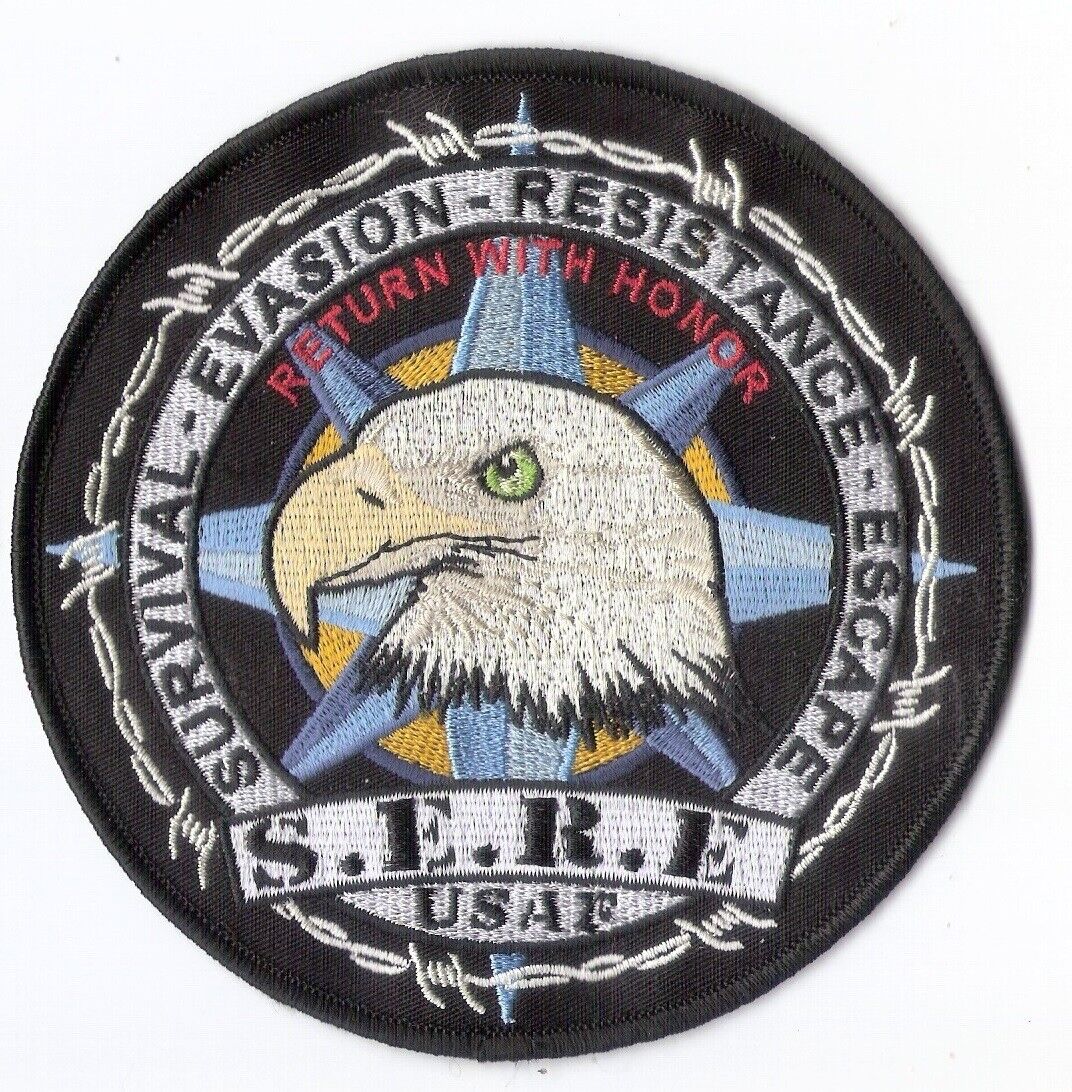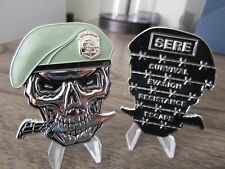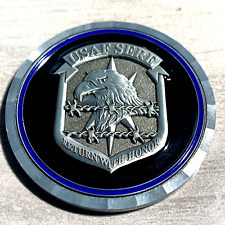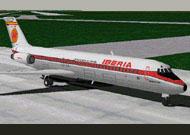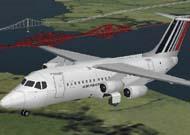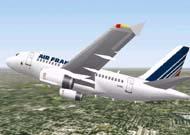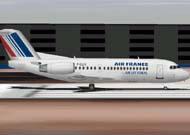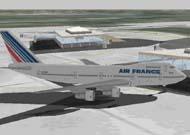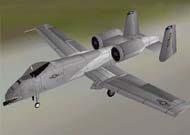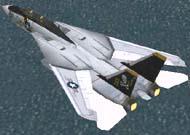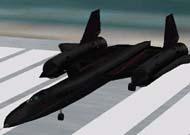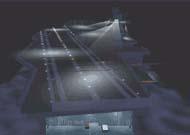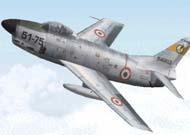When you click on links to various merchants on this site and make a purchase, this can result in this site earning a commission. Affiliate programs and affiliations include, but are not limited to, the eBay Partner Network.
History of the Organization of tUnited States Air Force SERE School Embroidered Patch - 5" in Diameter, merrowed edge with a wax (iron on) backing - Survival, Evasion, Resistance, and Escape - Return With Honor - POW/MIA - Air Force Survival School
USAF Survival Evasion Resistance Escape (SERE)
336TRG_SERE3 Combat Survival Training is established to provide aircrews and other designated personnel procedures and techniques in the use of equipment and employment of survival principles. Graduates of the U.S. Air Force Survival School at Fairchild Air Force base in Washington internalize the Survival, Evasion, Resistance and Escape (SERE) motto of “Return with Honor.” They spend weeks learning how to survive outdoors under any circumstances and to come home honorably. About 6,500 students go through the seven SERE courses each year. Five courses are held at Fairchild, and the other two are taught in Pensacola, Florida at the Naval Air Station and at Eielson Air Force Base in Alaska.
The majority of trainees at the USAF SERE School are Air Force aircrew members – pilots, navigators, flight engineers, loadmasters, boom operators, gunners, and other crew positions. Additionally, some intelligence officers and life support technicians may also attend. This school was created during the Vietnam War to prepare Air Force crews that were flying combat missions over Vietnam. As captured American aircrews became Prisoners of War (POWs), the school was created to provide crews the skills needed to survive and potentially escape enemy capture in North Vietnam.
The 336th Training Group oversees instruction at the U.S. Air Force SERE. All Air Force aircrew members must attend combat Survival Training, taught by the 22nd Training Squadron. Each course takes 19 days to complete, and 49 classes are taught each year. Students rise early in the morning, and spend many hours without sleep. They endure extremely hot and extremely cold temperatures to become SERE specialists.
Students spend six days in the Colville and Kaniksku National Forests mountains, while the rest of the course is conducted at Fairchild. Students first learn how to handle the psychological and physical stress of survival, after which they learn post-ejection procedures and how to handle parachute landings. They are also instructed in survival medicine. Shelter construction, gathering and cooking food, land navigation methods, evasion and camouflage, signaling and aircraft vectoring are all taught during students’ six-day stay in the mountains. After their stint outside, students return to Fairchild and learn about how to behave if they are captured.
Future instructors at SERE are taught by the 66th Training Squadron at Fairchild. This program lasts five and half months. It teaches students how to train aircrew members to survive no matter where they land. They learn several skills, including basic survival, navigation, arctic survival, how to teach, evasion, desert survival, rough land evacuation, tropics/river survival and coastal survival. Instruction in survival in different environments takes place in different areas of Washington, including the Calispell Mountain near Cusic; George, Washington; Tum-Tum; Oympic National Park; and Tillamook Bay, which is off the coast of Oregon.
Another course taught at Fairchild’s SERE is non-ejection water survival. This teaches aircrew members how to survive if they are in in aircraft without parachutes. This course takes two days to complete. Students learn how to signal rescue aircraft, about dangerous water animals, how to find food and drinkable water, the physical components of water survival and how to use a life raft properly.
How can you prepare for USAF Survival School?You won’t find too much concrete information or gouge on what to expect at SERE. This is designed so that you (the trainee) can actually benefit from the training. The school is designed to be as realistic as possible and part of the realism is based on surprise and the unpredictable stress you will experience.
What you can do is make sure you are in shape. Make sure you are fit and healthy and able to do well on the AF PFT. You will be hiking many miles a day with a heavy pack on your back while trying to evade capture – so make sure you are ready to do that. Make sure your gear is fitted properly and your boots are broken in prior to the first day in the bush. Pack plenty of good quality wool socks.
The 66th Training Squadron teaches the five-day resistance training orientation course. Students include U.S. Air Force SERE instructors and some Department of Defense personnel. The course includes instruction on the principles and theories to conduct Level C Code of Conduct resistance training laboratory instruction. Level C refers to military personnel who have a high risk of capture due to their ranks or seniority. This course focuses on resistance in prisoner of war camps. To receive upgrade to the 5 survival skill level, students must complete this course.
The 19-day, skill level 7 upgrade course for SERE training instructors occurs each year. It includes advanced survival instruction in the open ocean, barren arctic, barren desert and jungle. Training occurs in Alaska, Arizona, Hawaii, and Florida. Three to four days is spent in each location. Instructors learn to survive with little in the way of equipment, supplies and support.
The five-day Arctic Survival Training course is taught by Detachment 1 of the 66th Training Squadron at the Eielson Air Force Base in Alaska. Training occurs October through March. It was created for aircrews that fly in northern areas. Students learn to procure food and water, build fires, to signal and to build thermal shelters. Cold weather survival is the focus of this course.
The 66th Training Squadron, Detachment 2 at the Naval Air Station in Pensacola, Florida teaches a water survival course. The course takes four days to complete. Students simulate an over-the-water emergency that occurs in-flight. Parachute equipment procedures, drag training, after exit procedures and recovery training. Recovery training involves a landing over deep water and learning to use a raft.
Other activities of the SERE program include training Air Force Academy cadets and Air Force Reserve Officer Training Corps cadets. About 2,200 Air Force Reserve Officers’ Training Corps cadets and 1,200 Air Force Academy cadets are trained each summer. SERE instructors also teach civilian organizations, such as the Boy and Girl Scouts, schools and the Civil Air Patrol.
US Air Force Special OpsFinally a book on everything about PJ’s and CCT from their extensive training, the pipeline, to future mission profiles. Better, more in-depth info than I have ever found on the net. But this is just half of this book. If your looking for info about the planes, helos, jets and their capabilities this is the book you’re looking for
I have read every book on Air Force Special Ops, and by far this is the most current and illustrative. While the photos may be staged, considering the secret nature of Special Ops, real-time photos may not even exist, let alone be de-classified: they are very illustrative of many aspects of operations. There are so many books about SEALS, Special Forces, Rangers, etc. and AF SpecOps is so overlooked, it is about time they get some equal time. This book is the best I have seen, to date.
That Others May LiveThat Others May Live is the story of one of America’s most elite military units. The PJs–pararescue jumpers–are to the air force what the Green Berets are to the army and the SEALs are to the navy, even though they are less well known. There are only about 300 of them, and their main function is to rescue downed pilots, often behind enemy lines. They also perform civilian rescues. “There are no more capable rescuers than the PJs,” writes Jack Brehm, a 20-year PJ veteran who penned this book with journalist Pete Nelson. “No one else knows how to fall five miles from the sky to rescue somebody. No one else trains to make rescues in such a wide variety of circumstances and conditions on a mountaintop, in the middle of the Sahara, or 1,000 miles out from shore in hurricane-tossed seas.” Some readers will recall the PJs’ minor role in Sebastian Junger’s harrowing bookThe Perfect Storm; Brehm actually coordinated that PJ operation, and he tells his side of the story on these pages.
Survival, Evasion, Resistance, and Escape (SERE) is a program, best known by its military acronym, that provides U.S. military personnel, U.S. Department of Defense civilians, and private military contractors with training in evading capture, survival skills, and the military code of conduct. Established by the U.S. Air Force at the end of World War II, it was extended and consolidated during the Vietnam War (1959–1975) to the U.S. Marine Corps, and U.S. Navy and in the late 1980s to the U.S. Army. Most higher level SERE students are military aircrew and special operations personnel considered to be at high risk of capture.
Based on the experiences of the British and American pilots who managed to escape from and evade the Germans during World War II, and return to friendly lines, several private "clubs" were created during World War II. One such club was the "Late Arrivals' Club". This club, which had a "Flying Boot" as its identifying symbol, was strictly non-military. However, under the left collar of his uniform, the individual who had successfully escaped and/or evaded the enemy pinned the "Flying Boot" and although everyone knew it was not official, they did not question it being worn.
However the origins of what we now call SERE are firmly rooted in the leadership of Britain’s MI9 Evasion and Escape organisation, formed in February 1939 at the onset of WW2. Led by WW1 veteran Colonel (later Brigadier) Norman Crockatt, MI9 were formed to train air crew and Special Forces in evading enemy troops following bale out, forced landings or becoming cut off behind enemy lines. A training school was established in London, and Officers and instructors from MI9 also began visiting operational air bases, providing local training to air crews unable to be detached from their duties to attend formal courses.
MI9 went on to devise a multitude of evasion and escape tools. Overt items to aid immediate evasion after baling out, followed by Covert items (concealed compasses, silk and tissue maps etc.) hidden in uniforms and personal items for use to aid escape following capture.
Once the United States entered the war in 1941, MI9 travelled to Washington to discuss their now mature E&E training, devices and proven results with USAAF. As a result, the United States stood up their own Evasion and Escape organisation, known as MIS-X, based at Fort Hunt, Virginia.
Under the direction of Air Force General Curtis LeMay it was realized that it was much cheaper and more effective to train aircrews in Survival, Evasion, Resistance, and Escape techniques, than to have them languishing in enemy hands. He was responsible for SERE training at several bases/locations. In 1943, LeMay directed the establishment of a small program for Cold Weather Survival at RCAF Station Namao (formerly called Blatchford Field) in Alberta, Canada (There was a USAAF B29 unit assigned there and they attended Survival Training there with the British and Canadian Forces). In 1945 it was moved to Camp Carson, Colorado, and in 1948 at Marks Air Base, Nome, Alaska. The first instructors of the consolidated school were composed of experienced wilderness "civilian" volunteers and USAF military personnel with prior instructor experience. This initial cadre also included "USAF Rescuemen" from around Alaska, Colorado, Greenland, etc.
General LeMay attended the first class of instruction as a student. As time wore on, the expense and wisdom of having multiple locations for training was questioned and consolidation was begun. The hardest decision of that consolidation was where to locate the training base that offered the best environmental and logistical support for such a small but convoluted training program. Ultimately, the USAF consolidated at Stead AFB, Nevada. In the mid 1960s, the school was moved to Fairchild AFB, WA.
The U.S. Air Force SERE School is located at Fairchild AFB, Washington, while SERE Training for the U.S. Army is located at Fort Bragg, North Carolina and at Fort Rucker, Alabama. The Navy and Marine Corps SERE School has known locations at: the U.S. Navy Remote Training Site at Warner Springs, California, the remote Marine Corps Mountain Warfare Training Center (Bridgeport, California), and an annex of the Portsmouth Naval Shipyard in Kittery, Maine.
The largest SERE Course and only career-long SERE Instructor (now called SERE Specialists) cadre are located at US Air Force Survival School which is at Fairchild Air Force Base, Washington; each USAF SERE Specialist goes through a grueling selection process and if successful, attends the USAF SERE Specialist Training Course. Those that graduate (less than 10%) are awarded the Sage Beret, SERE Arch and SERE Flash. Following training, the Specialists are tasked with 45 weeks of intensive on-the-job training. Each graduate must attend Airborne School at the US Army Training Center located at Ft. Benning, GA. After completion of four years as an Instructor (Field Training) the Specialist may be tasked to train students worldwide. USAF SERE Specialists are required to complete an Associate's Degree in Survival and Rescue Sciences through the USAF Community College in order to continue to advance in their career field.
SERE Specialists will complete additional qualification training at specialized schools as required. Examples are Scuba Courses, Military Freefall Parachuting, Altitude chamber, etc. Assignment to each of the outlying schools requires additional training by the SERE Specialist. Upon reporting to the new assignment, each SERE Specialist must first complete that school's course (the same as an Aircrew member), and then be trained by the school's cadre in the specialized subject matter (and carry crews under supervision) before the newly assigned Specialist is "qualified" to teach without supervision.
At Edwards AFB, USAF SERE Specialists are tasked as "Test Parachutists" and required to perform multiple jumps on newly introduced / modified rescue systems, aircraft, and parachuting and / or ejection systems. This includes test parachuting newly designed canopies, harnesses, etc. Currently, they are the only Test Parachutists in the Department of Defense.
Student training for Level "B" medical aircrew was conducted at Brooks City-Base, Texas until the planned course closure on 30 September 2009. The Air Force conducts Arctic Survival Training – Cool School at Eielson Air Force Base, Alaska, and Parachuting and Non-Parachuting Water Survival Training at Fairchild AFB, Washington. The parachute water survival training--which was once located in Florida--ceased operations there in August 2015.
SERE training was also conducted at the US Air Force Academy in Colorado Springs from the late 1960s until 1995, enabling those USAF officers commissioned through USAFA to exempt from USAF SERE training at Fairchild AFB following undergraduate pilot or navigator training. In contrast, those USAF officers commissioned through AFROTC or OTS still had to complete SERE at Fairchild following flight training. In 1995, the resistance/escape element of the course at USAFA was abolished (see Controversies below), leaving the survival and evasion classes in a program called Combat Survival Training (CST).
The academy discontinued CST entirely in 2005. However, in summer 2008, some portions of the program, including resistance training, were reinstated. Following the summer of 2011, the scope of the CST program was reduced drastically and incorporated into the mandatory expeditionary skills training for budgetary reasons. Now, all USAFA graduates selected for pilot, air battle manager, or navigator training must complete SERE training at Fairchild after receiving their wings, along with their AFROTC and OTS graduate counterparts.
USAF SERE Specialists are considered DOD-wide subject matter experts in their field. USAF SERE Specialists are assigned to base level and to command staff as advisers.
ENSURING AIRMAN SURVIVALWhether it’s in the desert, the arctic, at sea, in the jungle or as a prisoner of war, Airmen are prepared for any situation. And it’s the Survival, Evasion, Resistance and Escape (SERE) specialists who train them. These elite instructors are experts on how to survive in the most remote and hostile environments on the planet. And it’s up to them to make sure that when a mission doesn’t go as planned, the Airmen involved are ready for anything. And we mean anything.
QUALIFICATIONS SUMMARYMINIMUM EDUCATIONCompletion of high school with eleventh-grade reading levelASVAB completion of the SERE physical ability and stamina test (PAST)Minimum score of 55 on SERE selection model completed in Tailored Adaptive Personality Assessment System (TAPAS)Meet psychological requirements for the SERE Specialist Training Orientation CourseAbility to complete a four-mile ruck march with a 60-pound pack in 60 minutes or lessAbsence of any speech impediment and ability to read aloud and speak distinctlyNormal color visionMeet FCIII physical and psychological qualifications for SERE Specialists and parachutist dutyCompletion of a current National Agency Check, Local Agency Checks and CreditCompletion of 8.5 weeks of Basic Military TrainingMust be between the ages of 17 and 39


